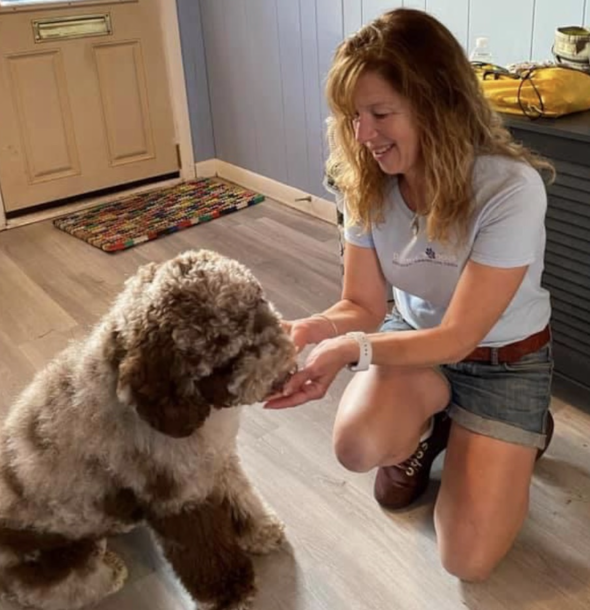Pets and Their People Blog
Fungi Facts for You and Your Four-Legged Loved Ones (Part Two)
In this series we continue to identify and discuss the top ten mushrooms that are poisonous to dogs and what to do if your dog decides to take a bite.
While we like to think that our dogs would know better than to snack on some fungi (some show no interest) being aware of – and able to identify – certain strains of poisonous mushroom could save us animal lovers a costly trip to the ER and even Buddy’s life!
Let’s take a closer look at a few more mushrooms that are poisonous to dogs:
Fibrecap
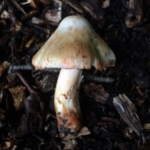
Inocybe is a genus of mushroom containing the toxin muscarine, which can cause excessive salivation, diarrhea, and even seizures in dogs.
- Commonly referred to as Fibrecap, this genus of mushroom has many different varieties, including deadly Fibrecap, torn Fibrecap, and white Fibrecap, all of which we should keep our dogs far away from!
- Inocybe tends to grow under trees and is especially common in Europe.
- While every variation of Inocybe should be avoided at all costs, perhaps the deadliest is Deadly Fibrecap, which tends to have a whitish coloring on both its cap and stem.
- Another mushroom species that tends to resemble the delicious mushrooms we find in the grocery store, we must be especially careful. The main identifying feature of these mushrooms is that they will stain red when touched or bruised, a feature that cannot be attributed to its look- alike edible mushrooms.
Ivory Funnel
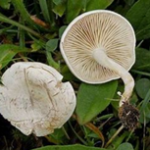
Clitocybe dealbata or Ivory Funnel is another toxic mushroom containing muscarine. As we know from the genus Inocybe, any mushroom containing muscarine is extremely toxic to dogs.
- Ivory Funnel is also sometimes called “sweating mushroom” because of the symptoms that the toxic muscarine causes.
- This little white, funnel shaped mushroom is another one that can be found on lawns or other grassy areas, which makes it one we should be especially careful to lookout for on our walks with our fur babies.
- This mushroom can also be found throughout Europe and North America.
- Though this mushroom is extremely toxic, death is rare, and luckily there is an antidote, but nonetheless, it should be avoided at all costs!
Webcaps
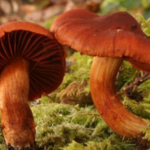
Cortinarius or Webcaps are another whole genus of mushrooms to watch out for when out with our four-legged loved ones; it also happens to be the largest genus of all mushrooms!
- There are over a thousand species of Cortinarius mushroom, making it very difficult to be able to identify each species on its own. However, one thing that they all have in common is their rusty brown to purple color and the fact that they are mycorrhizal, meaning they only grow around or on the roots of other plants, most commonly trees.
- Though not every mushroom in this genus is poisonous, it is in your and your dog’s best interest to stay away from any Cortinarius species. Those that are poisonous contains orellanine, which can cause kidney failure and/or death in dogs.
- Luckily, orellanine is fluorescent (under a black light), so it can be easy to distinguish between poisonous and non-poisonous species of Cortinarius.
- This genus of mushroom can be found all over the world, so anyone around the globe with beloved dogs in their home should keep an eye out for Cortinarius.
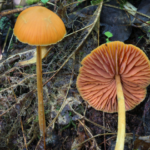
Pink Gills
Entoloma or Pink gills are a genus of mushroom that are all poisonous!
- These toxic mushroom can be found all across North America and Europe and are identifiable by their, you guessed it.. pink gills!
- The caps of these mushrooms are light gray to brown with a white stem and no ring.
- Entoloma has been known to be confused with the edible sweetbread mushroom. This common mix-up is the cause of some poisonings in people.
- The toxins in this genus of mushroom are known to cause vomiting, diarrhea, and liver damage, and even in some cases delirium or ongoing disruption in mood.
- Keep an eye out for clusters of these mushrooms; they can be found in many different environments from wooded areas to grassy fields, and even in chalkier, clay soil.
Dapperlings
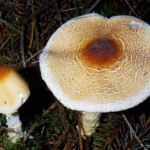
Lepiota or Dapperlings are another genus of mushroom and the last on our list.
- There are over 400 different species of Lepiota, with most being poisonous, and some being lethal, especially for dogs.
- These mushrooms contain amatoxins, making them incredibly dangerous for our dogs. Aside from the potential to kill, the toxins in these mushrooms can cause kidney and liver failure in dogs.
- Most of the mushrooms under this genus have small caps with slim stems that are usually whiteish in color. Many types of Lepiota are identifiable by the brown center on the top of the cap.
- Lepiota is found exclusively in calcareous (calcium-containing) soils, most commonly in Northern Europe, however they can be found all around the globe.
And there you have it, the top ten mushrooms that are most poisonous to dogs! It’s important to note that these are just a few of the many poisonous mushrooms that can be harmful to dogs.
If you suspect that your dog has ingested a poisonous mushroom, it’s important to reach out to your vet and/ or poison control for assistance with next steps and potential treatment.
Remember, symptoms of mushroom poisoning can range from mild gastrointestinal upset to vomiting, diarrhea, lethargy, seizures, and even coma or death.
While mushrooms can be a tasty treat for humans, even those that are edible to us can be incredibly dangerous to dogs. As a responsible dog parent, it’s important to be aware of the potential dangers and to keep a close eye on your furry friend when out on walks or in areas where mushrooms may be present.
REFERENCE:
Shane Hussey, B.S. in molecular and cell biology and B.S. in ecology and evolutionary biology. Shane is the product manager for rare disease at Variantyx Inc., previously a research fellow at UMass Amherst in fungal genetics and former founding president of UConn Mycology Club. He is currently pursuing a Master’s degree in data science at Northeastern University.
About the Author
